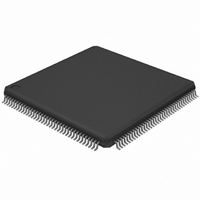LPC2388FBD144,551 NXP Semiconductors, LPC2388FBD144,551 Datasheet - Page 36

LPC2388FBD144,551
Manufacturer Part Number
LPC2388FBD144,551
Description
IC ARM7 MCU FLASH 512K 144LQFP
Manufacturer
NXP Semiconductors
Series
LPC2300r
Specifications of LPC2388FBD144,551
Program Memory Type
FLASH
Program Memory Size
512KB (512K x 8)
Package / Case
144-LQFP
Core Processor
ARM7
Core Size
16/32-Bit
Speed
72MHz
Connectivity
CAN, EBI/EMI, Ethernet, I²C, Microwire, MMC, SPI, SSI, SSP, UART/USART, USB OTG
Peripherals
Brown-out Detect/Reset, DMA, I²S, POR, PWM, WDT
Number Of I /o
104
Ram Size
98K x 8
Voltage - Supply (vcc/vdd)
3 V ~ 3.6 V
Data Converters
A/D 8x10b; D/A 1x10b
Oscillator Type
Internal
Operating Temperature
-40°C ~ 85°C
Processor Series
LPC23
Core
ARM7TDMI-S
Data Bus Width
16 bit, 32 bit
Data Ram Size
98 KB
Interface Type
CAN/I2C/I2S/SPI/SSP/UART/USB
Maximum Clock Frequency
72 MHz
Number Of Programmable I/os
104
Number Of Timers
4
Operating Supply Voltage
3.3 V
Maximum Operating Temperature
+ 85 C
Mounting Style
SMD/SMT
3rd Party Development Tools
MDK-ARM, RL-ARM, ULINK2, MCB2388, MCB2388U, MCB2388UME
Development Tools By Supplier
OM11012
Minimum Operating Temperature
- 40 C
On-chip Adc
8-ch x 10-bit
On-chip Dac
1-ch x 10-bit
Lead Free Status / RoHS Status
Lead free / RoHS Compliant
For Use With
OM11012 - BOARD EVAL FOR LPC2388568-3999 - BOARD EVAL FOR LPC23 ARM MCU622-1005 - USB IN-CIRCUIT PROG ARM7 LPC2K
Eeprom Size
-
Lead Free Status / Rohs Status
Lead free / RoHS Compliant
Other names
568-4323
935285417551
LPC2388FBD144-S
935285417551
LPC2388FBD144-S
Available stocks
Company
Part Number
Manufacturer
Quantity
Price
Company:
Part Number:
LPC2388FBD144,551
Manufacturer:
NXP Semiconductors
Quantity:
10 000
NXP Semiconductors
LPC2388_0
Preliminary data sheet
7.27.1 EmbeddedICE
7.27.2 Embedded trace
7.27 Emulation and debugging
The LPC2388 support emulation and debugging via a JTAG serial port. A trace port allows
tracing program execution. Debugging and trace functions are multiplexed only with
GPIOs on P2[0] to P2[9]. This means that all communication, timer, and interface
peripherals residing on other pins are available during the development and debugging
phase as they are when the application is run in the embedded system itself.
The EmbeddedICE logic provides on-chip debug support. The debugging of the target
system requires a host computer running the debugger software and an EmbeddedICE
protocol convertor. The EmbeddedICE protocol convertor converts the Remote Debug
Protocol commands to the JTAG data needed to access the ARM7TDMI-S core present
on the target system.
The ARM core has a Debug Communication Channel (DCC) function built-in. The DCC
allows a program running on the target to communicate with the host debugger or another
separate host without stopping the program flow or even entering the debug state. The
DCC is accessed as a coprocessor 14 by the program running on the ARM7TDMI-S core.
The DCC allows the JTAG port to be used for sending and receiving data without affecting
the normal program flow. The DCC data and control registers are mapped in to addresses
in the EmbeddedICE logic.
The JTAG clock (TCK) must be slower than
interface to operate.
Since the LPC2388 have significant amounts of on-chip memories, it is not possible to
determine how the processor core is operating simply by observing the external pins. The
ETM provides real-time trace capability for deeply embedded processor cores. It outputs
information about processor execution to a trace port. A software debugger allows
configuration of the ETM using a JTAG interface and displays the trace information that
has been captured.
The ETM is connected directly to the ARM core and not to the main AMBA system bus. It
compresses the trace information and exports it through a narrow trace port. An external
Trace Port Analyzer captures the trace information under software debugger control. The
trace port can broadcast the Instruction trace information. Instruction trace (or PC trace)
shows the flow of execution of the processor and provides a list of all the instructions that
were executed. Instruction trace is significantly compressed by only broadcasting branch
addresses as well as a set of status signals that indicate the pipeline status on a cycle by
cycle basis. Trace information generation can be controlled by selecting the trigger
resource. Trigger resources include address comparators, counters and sequencers.
Since trace information is compressed the software debugger requires a static image of
the code being executed. Self-modifying code can not be traced because of this
restriction.
Rev. 00.01 — 23 October 2007
1
⁄
6
of the CPU clock (CCLK) for the JTAG
Fast communication chip
LPC2388
© NXP B.V. 2007. All rights reserved.
36 of 57
















